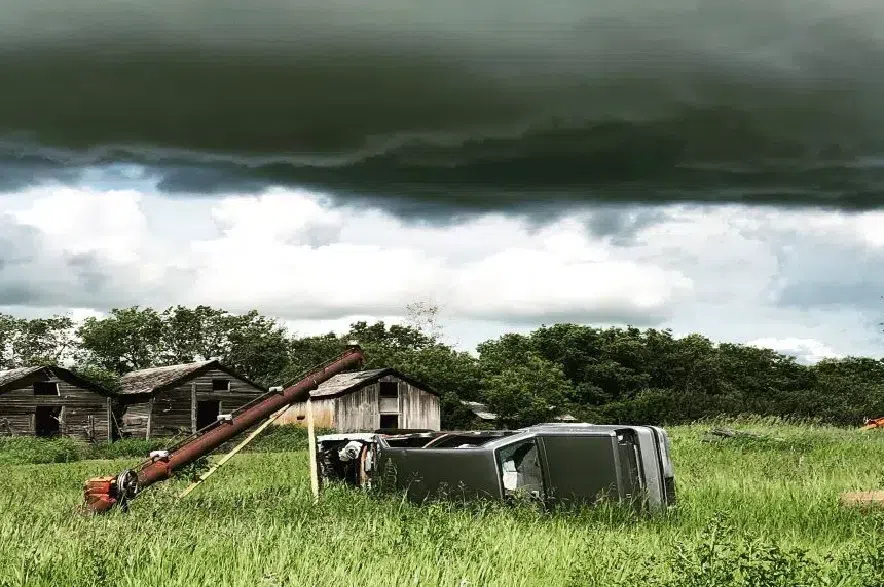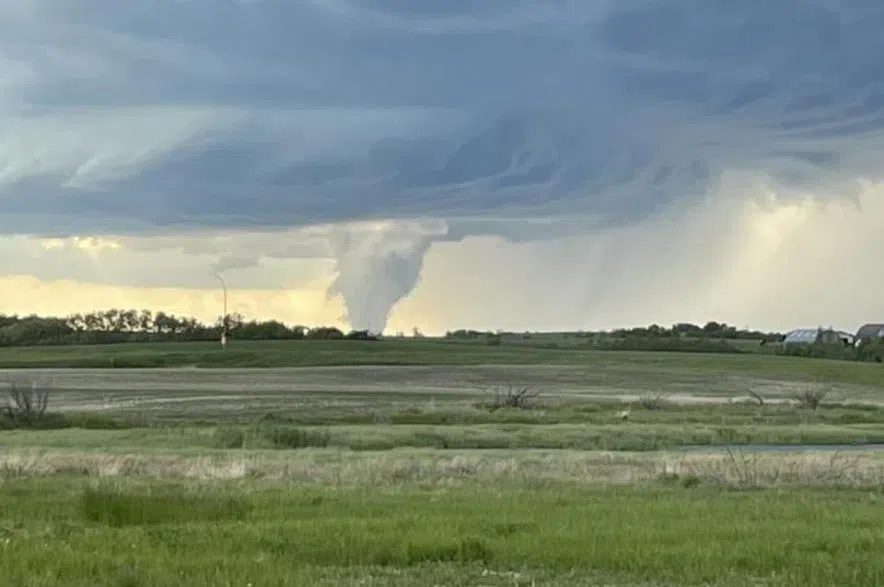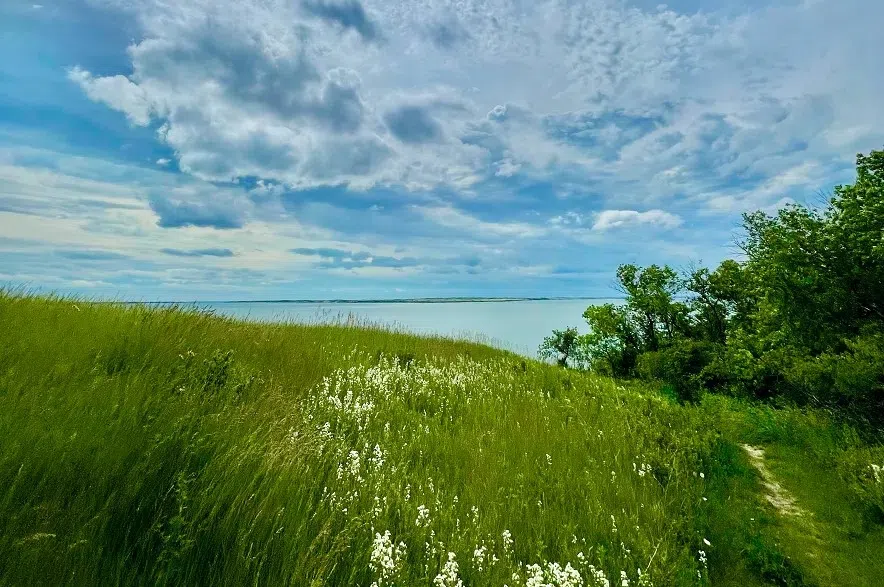As the calendar switches from June to July, many Saskatchewan residents are still wondering when summer is going to start.
June brought cooler than normal temperatures to the province, along with some severe storms, tornadoes and plenty of rain. Canada Day was more of the same, with overcast conditions and more storm and tornado warnings in the province.
The question now is whether July will see more unsettled conditions, or a return to the more consistent summer sunshine Saskatchewan residents have become used to in recent years.
Environment Canada’s Terri Lang pointed out that the last couple of years have been quite dry in Saskatchewan.
“That’s why people are sort of demanding their hot weather, because it was here the last couple springs, which is more unusual,” Lang said during an appearance on The Evan Bray Show on Tuesday.
Listen to Terri Lang on The Evan Bray Show:
This year, she said, is “more like the summers that we actually are supposed to be getting, if you go according to climatological averages.”
A welcome change for forecasters is the decreased concern around drought and forest fires, which dominated the news cycle at this time last year.
Environment Canada climatologist David Phillips said he feels a bit like the Maytag repairman this year, with very little to do.
“I’m just sitting here with my feet up and nothing’s really happening,” he said.
“Last year at this time it was all about the record fires across the country. It was about another year of drought on the prairies. It was the warmest summer on record. I mean, things were happening all over the place.”
But this year, he said “nature’s taken a breather,” and delivered much-needed rain across the Prairies.
Phillips said June saw nearly 35 per cent more precipitation than usual, and the months of April and May were also well-watered.
C95 asked Saskatchewanians to submit photos of the province’s first summer storm of 2024. This photo was taken near Prud’homme, SK. (Laurie Hafner/Facebook)
Over the last 100 years in Saskatoon, Phillips said there were only two other summers where June was both wetter and cooler than what was seen in 2024. In Regina, there have been four such years.
Phillips said temperatures have been “two and half degrees cooler than normal,” and most of the province hasn’t yet seen temperatures above 30 C.
The cool conditions mean the moisture does not evaporate as quickly into the atmosphere, Phillips explained, resulting in more moisture sticking around.
The north central region bore the brunt of some very heavy rain in June. Last week saw rainfall warnings issued for the central part of the province due to some significant downpours in those areas.
Lang said the northern part of province has received “more than their fair share” of rain. She said Saskatoon specifically has not had a wet spring like this since 2020 when the city saw 106.9 millimeters of rain.
This year, the number was up to 112 millimeters of rain, making this the 18th wettest June on record.
Lang also said it has been a busy summer for tornadoes compared to last year, when there was just one recorded tornado.
“So far we seem to have them falling out of the sky every weekend,” said Lang, pointing to the wet conditions as a factor.
“It’s been busier than the last few years just because we had a wet spring, and that’s feeding into more of the storms.”
The amount of moisture has prompted optimism from those in the agriculture sector about what it means for Saskatchewan’s crops, but many farmers are starting to get worried about the amount of moisture in the ground, which has led to localized flooding in some areas.
Phillips said a farmer friend told him there’s still time to produce a great crop this year “if we can get some warmth and some sun.
“I think that’s coming,” he said.
Over the next seven days, Phillips said nighttime temperatures should be in the double digits and daytime highs should hover in the 20s. Phillips also said he expects less rain in the forecast in the coming days.
He said heading into the weekend and by next Monday, there are forecasted highs of 29 C in Saskatoon and 28 C in Regina, which he hasn’t seen so far this year.
After that, Phillips said he expects it to feel like the “dog days of summer” with high heat and humidity. He said models are calling for warmer-than-normal conditions in July, August and September.
“I think the warmth is coming. You’re not sort of out in the cold with regards to this summer. I think it’s just been delayed,” said Phillips.
Listen to David Phillips on The Evan Bray Show:
Lang was more cautious in her predictions for the rest of the summer.
“Well, the weather models want to keep pushing it in,” said Lang about the coming heat.
But, she said, her models often suggest hot and dry weather will move into the province, but by the time it rolls around it would either fizzle out or stay farther west.
“I think I’m going to stop promising it,” said Lang.
Lang pointed out that there were predictions saying June would bring above-average for temperatures to Saskatchewan.
“It actually was cooler than average across the province, so it just goes to show we’re not always right,” she said.
Agriculture minister says farmers remain optimistic
David Marit, Saskatchewan’s agriculture minister, also joined the Evan Bray Show to discuss the effects the increase in rain has had on the province.
“The crops look good, and I was talking to quite a few farmers over the last few days, and you know, they’re pretty optimistic. Things look pretty good,” said Marit. “Even the pastures are looking pretty good.”
After struggles with drought in 2023, Marit said everybody is hoping for an excellent crop this year.
“Hopefully that will obviously help build the crop reserves back up again,” he said.
Marit said water levels in the province remain quite high as a result of the recent rainfall.
“Our water levels are right near the top, and (Lake) Diefenbaker’s even higher this year than it was last year at this time,” the minister said. “We could be two to two-and-a-half metres higher than we were last year at this time.”
Marit noted that the Diefenbaker Reservoir has more water in it than all the reservoirs in Alberta combined.
David Marit said a metre of water in Lake Diefenbaker “will provide a community of 300,000 people enough water for more than 15 years.” (Alex Brown/650 CKOM)
“It’s also my understanding that a metre of water in Lake Diefenbaker will provide a community of 300,000 people enough water for more than 15 years,” explained Marit.
Marit said they decided to hold off on filling Lake Diefenbaker this past year.
“Obviously, that was a brilliant thing to do. And we’re seeing those levels now where we’re hitting quite a bit higher than we were a year ago at this time,” said Marit.
–with files from 980 CJME’s Kaleb Sebastian













